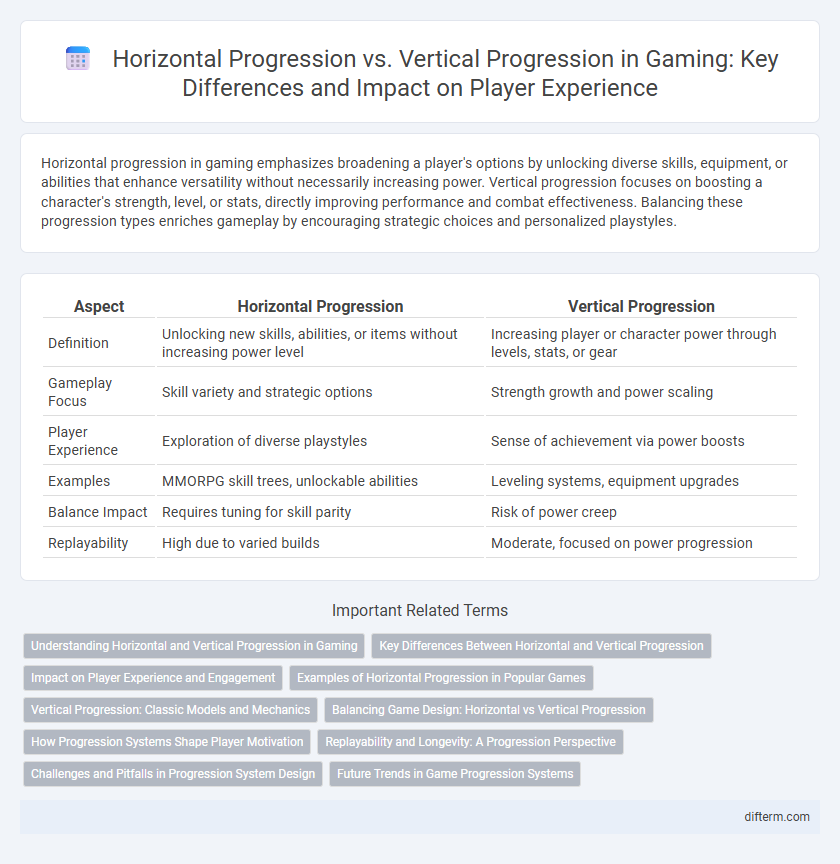Horizontal progression in gaming emphasizes broadening a player's options by unlocking diverse skills, equipment, or abilities that enhance versatility without necessarily increasing power. Vertical progression focuses on boosting a character's strength, level, or stats, directly improving performance and combat effectiveness. Balancing these progression types enriches gameplay by encouraging strategic choices and personalized playstyles.
Table of Comparison
| Aspect | Horizontal Progression | Vertical Progression |
|---|---|---|
| Definition | Unlocking new skills, abilities, or items without increasing power level | Increasing player or character power through levels, stats, or gear |
| Gameplay Focus | Skill variety and strategic options | Strength growth and power scaling |
| Player Experience | Exploration of diverse playstyles | Sense of achievement via power boosts |
| Examples | MMORPG skill trees, unlockable abilities | Leveling systems, equipment upgrades |
| Balance Impact | Requires tuning for skill parity | Risk of power creep |
| Replayability | High due to varied builds | Moderate, focused on power progression |
Understanding Horizontal and Vertical Progression in Gaming
Horizontal progression in gaming emphasizes acquiring diverse skills, abilities, or equipment without significantly increasing character power, enhancing gameplay variety and strategy. Vertical progression focuses on character growth through level-ups, stat improvements, and unlocking stronger gear, driving a sense of continuous power advancement. Understanding the balance between horizontal and vertical progression helps developers create engaging experiences that maintain player interest by combining skill diversification with meaningful power scaling.
Key Differences Between Horizontal and Vertical Progression
Horizontal progression in gaming emphasizes skill development, character customization, and unlocking diverse abilities without increasing power levels, fostering variety and strategic depth. Vertical progression centers on power scaling, where players advance by acquiring stronger gear, higher stats, and more impactful abilities, directly boosting character effectiveness. The key differences lie in horizontal progression promoting balanced growth and player choice, while vertical progression drives measurable power growth and competitive ranking.
Impact on Player Experience and Engagement
Horizontal progression in gaming enhances player experience by offering a wider variety of skills, abilities, or equipment without increasing character power, fostering creativity and strategic diversity. Vertical progression intensifies engagement through continuous power growth and a clear sense of achievement and reward, driving motivation to overcome increasingly difficult challenges. Balancing both systems can sustain long-term player interest by combining exploration with tangible progression milestones.
Examples of Horizontal Progression in Popular Games
Games like *The Legend of Zelda: Breath of the Wild* and *Monster Hunter: World* showcase horizontal progression by expanding player abilities and equipment options without necessarily increasing character level or power. Titles such as *Minecraft* and *Destiny 2* emphasize exploration and skill diversification, allowing players to unlock new crafting recipes or customize gear to fit various playstyles. This type of progression fosters player creativity and strategic choices, enhancing long-term engagement without relying on traditional leveling systems.
Vertical Progression: Classic Models and Mechanics
Vertical progression in gaming is characterized by linear advancement through increasingly difficult levels, often marked by character upgrades, improved gear, and new abilities. Classic models include role-playing games (RPGs) where players enhance stats and skills to overcome tougher challenges, fostering a sense of growth and accomplishment. Mechanics such as experience points (XP), skill trees, and loot systems are fundamental to sustaining player engagement through clear milestones and measurable progress.
Balancing Game Design: Horizontal vs Vertical Progression
Balancing game design between horizontal and vertical progression requires carefully managing player growth and engagement by offering meaningful choices and variety without overwhelming players with constant power scaling. Horizontal progression emphasizes acquiring diverse skills, abilities, or equipment that broaden gameplay options, while vertical progression focuses on increasing player stats or power levels to overcome stronger challenges. Effective balance enhances player satisfaction by encouraging strategic decision-making and maintaining a steady, rewarding sense of advancement.
How Progression Systems Shape Player Motivation
Horizontal progression enhances player motivation by offering diverse skills, abilities, or customization options without increasing character power, fostering creative expression and strategic variety. Vertical progression drives motivation through measurable power gains, leveling up, and unlocking stronger equipment, appealing to players' desire for tangible improvement and achievement. Balancing these systems ensures sustained engagement by catering to different player preferences and maintaining a rewarding gameplay loop.
Replayability and Longevity: A Progression Perspective
Horizontal progression in gaming enhances replayability by offering diverse skills, equipment, or customization options without significantly increasing difficulty, encouraging players to experiment with different playstyles. Vertical progression increases game longevity through a steady power or level advancement, providing a clear sense of achievement and motivating sustained engagement to overcome tougher challenges. Balancing both progression types ensures varied gameplay experiences while maintaining long-term player investment.
Challenges and Pitfalls in Progression System Design
Horizontal progression in gaming spreads player advancement across diverse skills or abilities, reducing reliance on grinding but risking player overwhelm due to complexity. Vertical progression emphasizes power scaling, offering clear, motivating goals but can lead to imbalance and repetitive gameplay if not carefully balanced. Designing progression systems requires a strategic blend to maintain engagement, avoid bottlenecks, and prevent player frustration.
Future Trends in Game Progression Systems
Future trends in game progression systems emphasize hybrid models combining horizontal and vertical progression to enhance player engagement and replayability. Horizontal progression focuses on expanding player skills and abilities without increasing power levels, promoting diverse gameplay styles, while vertical progression rewards players with increased stats and power, driving competition. Emerging technologies like AI-driven dynamic difficulty adjustment and personalized progression paths enable more adaptive and immersive experiences tailored to individual player preferences.
horizontal progression vs vertical progression Infographic

 difterm.com
difterm.com